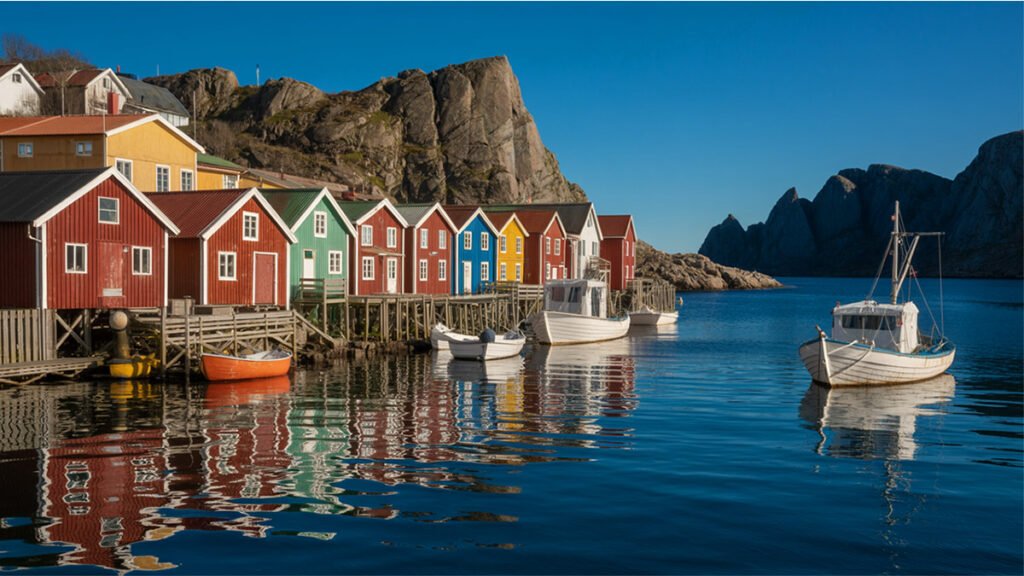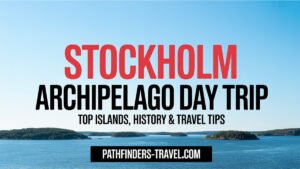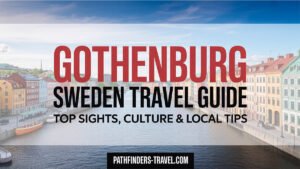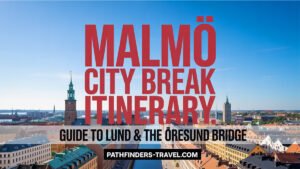Estimated reading time: 19 minutes
Key Takeaways
- The Bohuslän coast features rugged granite shorelines and over 8,000 islands, creating one of Sweden’s most picturesque coastal landscapes.
- Smögen’s boardwalk (Smögenbryggan) is lined with colorful fishing huts converted into restaurants and shops, making it a must-visit destination.
- Marstrand island offers a perfect day trip with its car-free streets, historic fortress, and charming coastal atmosphere.
- The imposing Carlsten Fortress stands as a testament to Marstrand’s strategic importance in Swedish maritime history.
- The best time to visit the Bohuslän coast is during summer (June-August) for vibrant atmosphere or shoulder season (May/September) for fewer crowds.
Table of Contents
- Introduction
- Discovering the Bohuslän Coast
- Visiting Smögen, Sweden
- Marstrand Island Day Trip
- Practical Tips for Your Coastal Adventure
- Frequently Asked Questions about Bohuslän Coast Villages
- Conclusion
Introduction
Sweden’s Bohuslän coast is a hidden gem along the country’s western shoreline, offering visitors a perfect blend of natural beauty and maritime heritage. This spectacular coastal region stretches north from Gothenburg, revealing a breathtaking landscape of smooth granite rocks, clear blue waters, and charming fishing villages that have maintained their authentic character through centuries. For travelers seeking an escape from busy city life, the best fishing villages Bohuslän coast provides the perfect setting for relaxation and discovery.
What makes this region truly special is its rich seafaring history, which has shaped the culture and traditions that continue to thrive today. From the bustling boardwalk of Smögen to the historic fortress of Marstrand, each village along this coastline tells its own unique story. Whether you’re interested in visiting Smögen Sweden to experience its vibrant harbor life or planning a Marstrand island day trip to explore centuries of Swedish history, the Bohuslän coast offers experiences that will stay with you long after your journey ends.
Want to see this for yourself? Click here to watch the video from this point.
Discovering the Bohuslän Coast
Discovering the Bohuslän Coast Villages and Landscape
The Bohuslän coast is characterized by its stunning granite shoreline that stretches across more than 8,000 islands and islets. This unique landscape was shaped by ancient glaciers, resulting in smooth, polished rock formations that contrast beautifully with the deep blue waters of the North Sea. The coast’s natural beauty is complemented by a rich maritime heritage that spans centuries, with fishing and seafaring deeply embedded in the local way of life. [SOURCE]

What sets the fishing villages of this region apart is their distinct character and charm. Many feature car-free streets lined with traditional wooden houses painted in bright colors – primarily the iconic Swedish red, yellow, and white. These villages offer a glimpse into authentic coastal life, with many still functioning as working fishing communities. The smell of salt air mixes with the aroma of freshly caught seafood, which has earned the region recognition as a culinary destination, particularly for its lobster, oysters, and shrimp.
The landscape of Bohuslän creates a perfect setting for exploration, with hiking trails and boat routes that weave through the archipelago. One notable natural treasure is Kosterhavet National Park, Sweden’s first marine national park, home to unique marine life and pristine beaches. The park’s underwater diversity makes it a paradise for snorkelers and divers, while its above-water scenery attracts photographers and nature lovers from around the world. [SOURCE]
Notable and Less-Known Villages
While Smögen and Marstrand often capture the spotlight, the Bohuslän coast is dotted with several lesser-known villages that offer equally rewarding experiences without the crowds:
- Fiskebäckskil: This charming village features narrow, winding streets lined with well-preserved wooden houses and colorful gardens. It’s known for its relaxed atmosphere and the Gullmarsstrand Hotell, which offers a world-class spa with sea views. The village provides an authentic glimpse into the coastal lifestyle of the region. [SOURCE]
- Bohus-Malmön: This small island community blends natural beauty with industrial history. Visitors can enjoy sandy beaches, rocky coves, and hiking trails that lead through remnants of the island’s granite quarrying past. The island’s well-preserved quarry sites tell the story of an industry that once supplied stone to cities across Europe. [SOURCE]
- Grundsund: With its picture-perfect harbor lined with colorful fishing boats and traditional boathouses, Grundsund offers classic Swedish coastal charm. The village is known for its seafood restaurants and the opportunity to witness an active fishing community at work. Walking along its coastal pathways provides stunning views of the surrounding archipelago. [SOURCE]
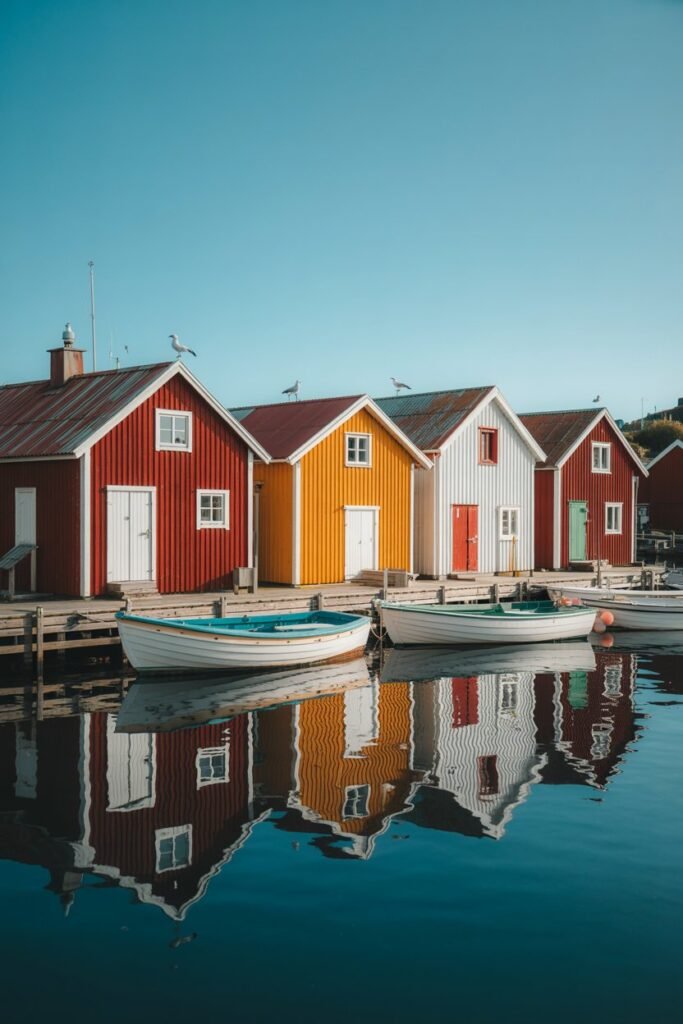
These villages, along with dozens of others that dot the coastline, each have their own distinct character and appeal. They set the stage for our deeper exploration of the region’s two most famous destinations: Smögen and Marstrand.
Visiting Smögen Sweden – Harbor Life and Boardwalk Guide
Overview
Smögen stands as one of the brightest jewels along the Bohuslän coast, capturing the hearts of visitors with its vibrant atmosphere and authentic charm. This small fishing community has grown into one of Sweden’s most popular summer destinations while maintaining its traditional character and working harbor. Visiting Smögen Sweden offers a perfect blend of natural beauty, maritime heritage, and lively coastal culture. [SOURCE]
The village has a rich history dating back to the 17th centDominating Marstrand’s skyline, Carlsten Fortressury, when it first emerged as a significant fishing settlement. Over the centuries, Smögen developed into an important hub for the herring industry, which brought prosperity and growth to the community. Today, while tourism has become a major economic driver, fishing remains an important part of local life and identity, giving visitors an authentic glimpse into Swedish coastal traditions.
Smögen Boardwalk Guide
The heart and soul of Smögen is undoubtedly its famous boardwalk, known locally as Smögenbryggan. This wooden promenade stretches for nearly a kilometer along the harbor, lined with a row of vibrantly painted former fishing huts that have been transformed into shops, restaurants, and cafés. The boardwalk creates one of Sweden’s most photographed and instantly recognizable scenes, with its colorful buildings reflected in the clear waters of the harbor. [SOURCE]
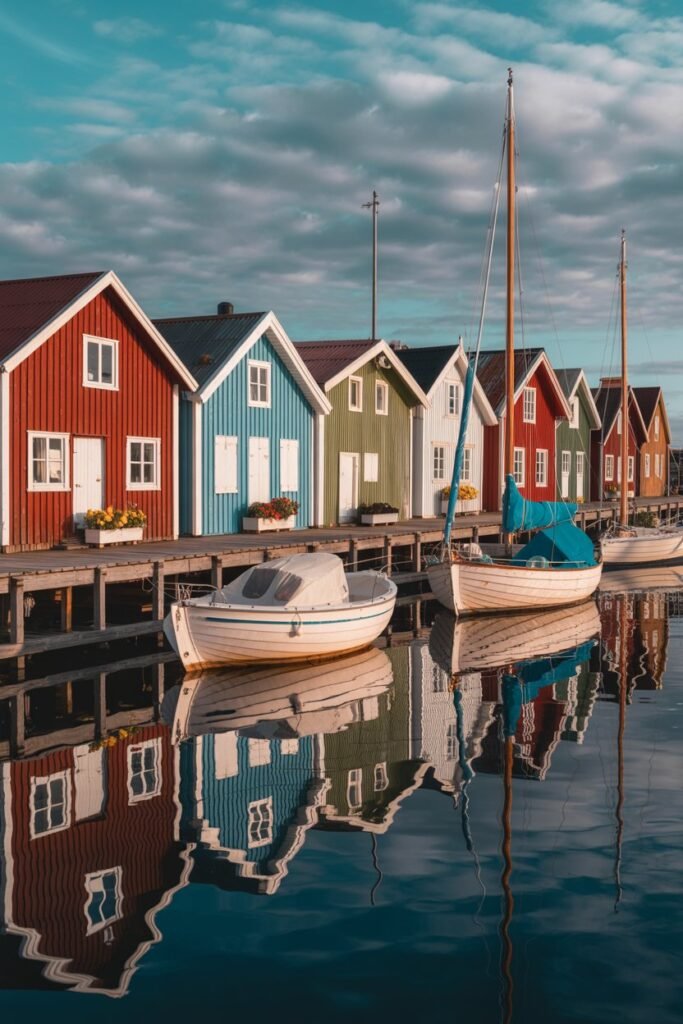
For the best experience on the Smögen boardwalk:
- Visit during the golden hour just before sunset when the low sun bathes the colorful buildings in warm light, creating perfect photo opportunities.
- Sample local seafood at one of the harbor restaurants – the shrimp sandwich (räkmacka) is a must-try Swedish classic, and Smögen’s version features fresh shrimp caught in nearby waters.
- Explore the small boutiques selling everything from local handicrafts to high-end fashion and marine-inspired home décor.
- If visiting during peak season (July), arrive early in the morning or later in the evening to avoid the biggest crowds.
The boardwalk is equally charming in different seasons. Summer brings buzzing energy with outdoor dining and live music, while spring and fall offer a more serene atmosphere where you can better appreciate the architecture and natural setting. [SOURCE]
Relaxation & Events in Smögen
Beyond the boardwalk, Smögen offers various experiences that highlight different aspects of coastal life:
- Treat yourself to a day of relaxation at Smögens Hafvsbad, a historic spa hotel where you can enjoy saunas, hot tubs, and treatments with stunning sea views. The spa’s outdoor pools allow you to soak while watching boats sail in and out of the harbor.
- If visiting in September, don’t miss the Island of Light festival, when the entire village becomes an open-air art gallery with light installations created by international artists. The illuminated boardwalk and surrounding rocks create a magical atmosphere that transforms the familiar daytime views.
- For a hands-on experience of local traditions, join a lobster safari (September to November) or crayfish safari (summer months). These guided boat trips take you out with local fishermen to pull up traps and learn about sustainable fishing practices before enjoying your fresh catch.
Smögen is busiest during late June to mid-August, when the population swells from about 1,500 year-round residents to tens of thousands of visitors. During this period, the village buzzes with energy, markets, and events. For a more relaxed experience, consider visiting in early June or September when the weather is still pleasant but crowds are thinner. [SOURCE]
Many visitors arrive by car, but parking in Smögen itself can be challenging during peak season. A practical alternative is to park in nearby Kungshamn and either walk across the connecting bridge (about 20 minutes) or take a short bus ride. This approach lets you enjoy the beautiful approach to Smögen while avoiding parking headaches.
Marstrand Island Day Trip – Itinerary and Coastal Attractions
Overview of Marstrand Island Day Trip
A Marstrand island day trip offers visitors a perfect blend of history, natural beauty, and coastal charm, all within easy reach of Gothenburg. Located just 50 kilometers northwest of Sweden’s second-largest city, Marstrand provides a wonderful contrast to the urban experience, making it ideal for travelers seeking to experience different facets of Swedish culture. [SOURCE]
What makes Marstrand special is its unique atmosphere. The island is entirely car-free, creating a peaceful environment where narrow streets wind between charming wooden buildings. Along the waterfront, elegant 19th-century wooden villas stand as reminders of Marstrand’s heyday as a fashionable royal resort. These grand houses, with their ornate verandas and detailed woodwork, contrast with the simpler fishermen’s cottages in the older parts of town.
Marstrand has a fascinating dual identity – it’s both a historic maritime stronghold and a stylish sailing resort. The island attracts visitors seeking both historical exploration and outdoor recreation, with activities ranging from fortress tours to sailing, hiking, and swimming at small beaches tucked among the rocks.
Suggested Itinerary
To make the most of your Marstrand island day trip, follow this practical itinerary:
- Morning: Begin your day by taking the passenger ferry from Koön (the mainland part of Marstrand) to the island. The ferry crossing takes just 5 minutes, operates year-round, and runs frequently throughout the day.
- Mid-morning: Start with a guided tour of Carlsten Fortress (more details in the next section) to learn about the island’s strategic importance and colorful history.
- Lunch: Enjoy a seafood lunch at one of the harbor restaurants. Marstrand Havshotell and Grand Hotel Marstrand both offer excellent dining with views of the harbor and passing sailboats.
- Afternoon: Take a scenic walk around the island’s coastal path (about 3 km), which offers stunning views of the surrounding archipelago, Skallens Lighthouse, and interesting rock formations like the narrow passage called Nålsögat (“The Eye of the Needle”).
- Late afternoon: Explore the charming village streets, browse boutique shops, and perhaps stop for fika (Swedish coffee break) at a local café.
This itinerary allows you to experience both the historical and natural highlights of Marstrand while still leaving time to soak in the relaxed island atmosphere.
Carlsten Fortress Marstrand History and Visitor Highlights
Dominating Marstrand’s skyline, Carlsten Fortress (Carlstens fästning) stands as an imposing symbol of Sweden’s military past. Construction of this massive stone fortress began in 1658, shortly after the Bohuslän region was transferred from Danish to Swedish control through the Treaty of Roskilde. The fortress was named after King Carl X Gustav and was designed to protect Sweden’s newly acquired western coast. [SOURCE]
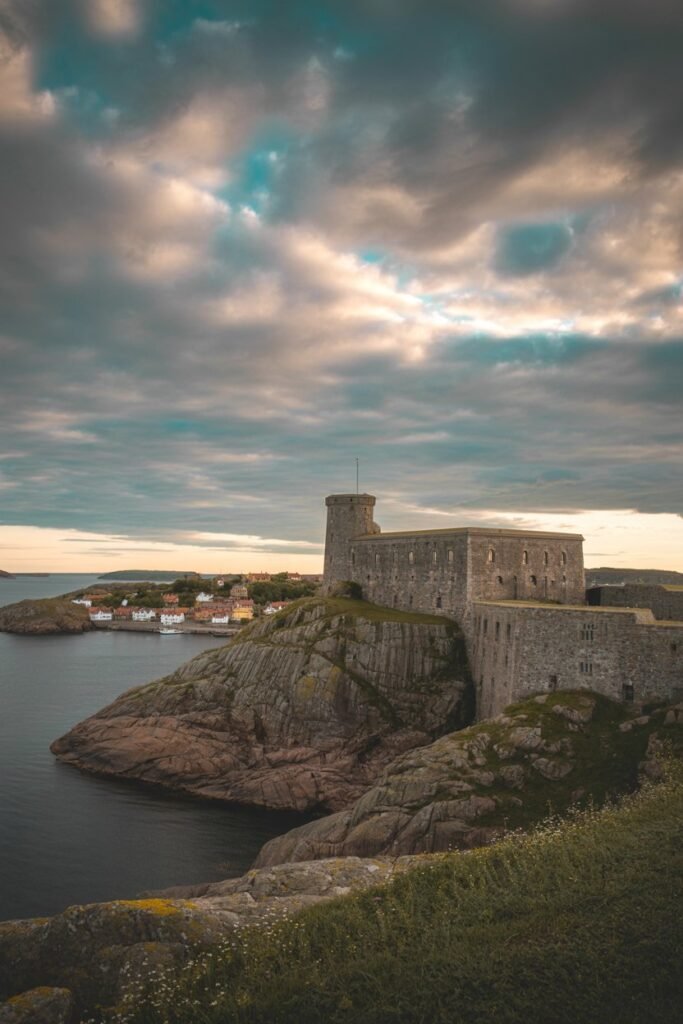
The Carlsten fortress Marstrand history spans over three centuries, during which it was continuously expanded and reinforced. It served not only as a military installation but also as a prison for some of Sweden’s most notorious criminals. The fortress was finally decommissioned as a military facility in the early 20th century but remains remarkably well-preserved, offering visitors a vivid glimpse into Sweden’s defensive past.
Key historical highlights include:Marstrand Island Day Trip
- The fortress withstood several sieges, including a major Danish attack during the Great Northern War (1700-1721).
- It housed famous prisoners like the “Long Fellow” Lars Gathenhielm, a Swedish privateer, and Metta Fock, one of few women imprisoned here.
- The fortress is associated with the story of Lasse-Maja, a legendary Swedish thief who dressed as a woman to commit crimes and later wrote a popular autobiography while imprisoned at Carlsten.
Visitor Experience at Carlsten Fortress
A visit to Carlsten Fortress today offers much more than just historical facts – it’s an immersive experience that brings the past to life:
- Guided tours take you through massive stone corridors, into damp dungeons, and up to panoramic viewpoints on the ramparts. Guides share colorful stories about prison escapes, daily military life, and the strategic importance of Marstrand in Sweden’s defense system.
- The Commander’s Residence within the fortress has been preserved with period furniture and military artifacts, providing insight into how officers lived within these stone walls.
- Throughout the year, the fortress hosts special events including historical reenactments, concerts, and theatrical performances that take advantage of the dramatic setting.
- From the highest tower, visitors can enjoy spectacular 360-degree views of Marstrand town, the surrounding archipelago, and the open sea beyond – the same strategic vantage point that made this location so important militarily.
The fortress is open to visitors year-round, though hours are more limited outside the summer season. Guided tours are available in English during peak season, and audio guides provide information in multiple languages throughout the year. For the most atmospheric experience, consider visiting during one of the evening lantern tours offered in summer and during special holiday periods.
Practical Tips for Your Coastal Adventure
Travel Logistics
Planning your visit to the Bohuslän coast requires some practical considerations to ensure a smooth and enjoyable experience. Here are essential tips to help you make the most of your coastal adventure:
Best Time to Visit
- High season (late June to mid-August): This is when the coast comes fully alive with warm weather, longer daylight hours, and all attractions open. However, this period also brings higher prices and larger crowds, particularly in popular spots like Smögen and Marstrand.
- Shoulder season (May-early June and September): These months offer a wonderful balance of pleasant weather, fewer crowds, and slightly lower prices. Many restaurants and attractions remain open, and you’ll get a more authentic experience of coastal life.
- Winter (November-April): While quieter and with limited services, winter brings a different kind of beauty to the coast. The stark granite landscapes against winter skies create dramatic scenery, and you’ll have many places almost to yourself.
Transportation
Gothenburg serves as the main gateway to the Bohuslän coast and is well-connected by air, train, and bus to other parts of Sweden and Europe. From there, you have several options to explore the coast:
- Rental car: This offers the most flexibility for exploring multiple villages and remote areas. The coastal road (E6 highway and smaller roads branching off) is scenic and well-maintained.
- Public buses: Västtrafik operates regular services connecting Gothenburg with major coastal towns. The #840 and #841 buses serve many fishing villages, though service may be limited outside summer months.
- Boat tours: During summer, passenger boats connect various coastal points, offering a unique perspective of the archipelago landscape. [SOURCE]
Accommodation
The Bohuslän coast offers diverse accommodation options, but advance booking is essential, especially for summer visits:
- Hotels and guesthouses: Found in larger villages like Smögen, Marstrand, and Fjällbacka, these range from luxury spa hotels to simpler family-run establishments.
- Vacation rentals: Renting a traditional cottage or apartment gives you more space and the option to self-cater. Many feature charming coastal décor and waterfront locations.
- Camping: Several well-equipped campgrounds along the coast cater to both tents and campervans, offering an affordable option with stunning natural settings.
Consider staying in central locations like Lysekil or Kungshamn, which provide easy access to multiple villages while typically offering more accommodation choices than smaller fishing communities. Budget-conscious travelers might want to look at options slightly inland, where prices tend to be lower than directly on the coast.
Cuisine & Cultural Tips
The Bohuslän coast is renowned for its seafood, considered among the best in Sweden. Don’t miss these local specialties:
- Freshly caught shrimp (räkor) – often served simply with bread, mayonnaise, and lemon
- Lobster (hummer) – the Bohuslän lobster season opens in late September and is celebrated with special menus
- Oysters (ostron) – local varieties are prized for their clean, briny flavor
- Smoked or marinated herring (sill) – prepared in countless traditional ways
When interacting with locals, keep these cultural tips in mind:
- Swedes generally value personal space and may seem reserved at first, but are usually friendly and helpful once engaged in conversation.
- Remove your shoes when entering someone’s home – this is a widely observed custom throughout Sweden.
- In nature areas, follow the principle of “allemansrätten” (right of public access), which allows you to enjoy the outdoors freely but comes with responsibilities to respect private property and the environment.
Further Exploration
If you have extra time to explore beyond Smögen and Marstrand, consider these additional destinations along the Bohuslän coast:
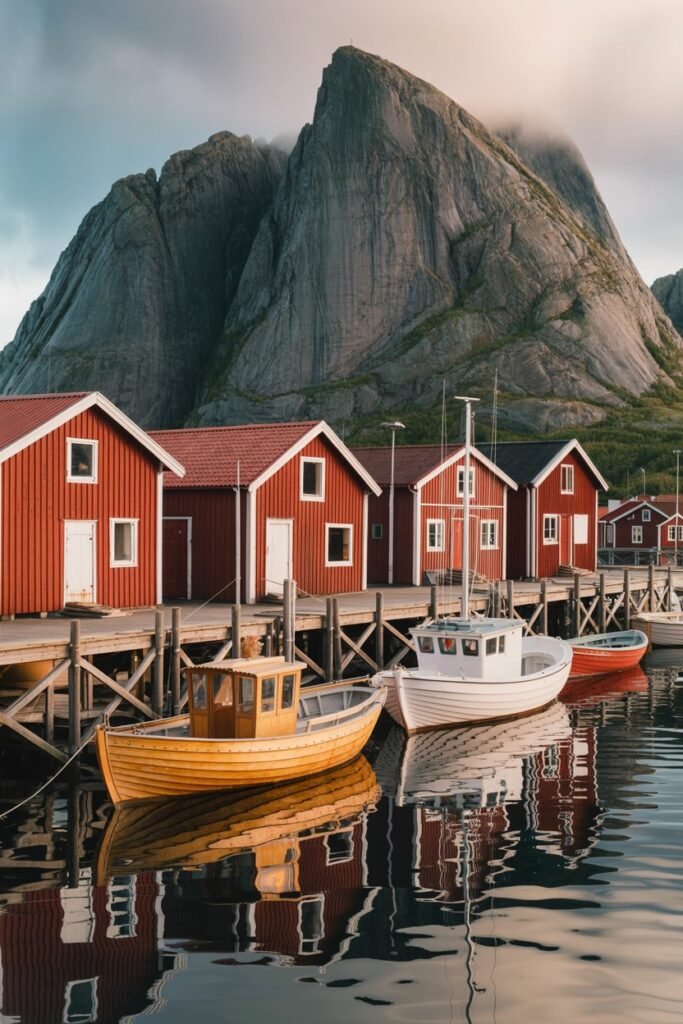
- Fjällbacka: Made famous as the setting for Camilla Läckberg’s crime novels, this picturesque village offers dramatic cliff views from Vetteberget and boat trips to the Weather Islands (Väderöarna).
- Kosterhavet National Park: Sweden’s first marine national park encompasses the Koster Islands and surrounding waters, home to over 6,000 marine species. Rent bicycles to explore the car-free islands and learn about marine conservation at the visitor center.
- Lysekil: This larger coastal town features the excellent Havets Hus aquarium, focusing on local marine life, and the beautiful Stångehuvud nature reserve with its distinctive pink granite formations.
For those interested in local handicrafts, look for studios and workshops specializing in traditional skills like pottery, textile weaving, and glassblowing. Many artisans welcome visitors and offer the chance to purchase unique, locally-made souvenirs that reflect the coastal heritage.
Frequently Asked Questions about Bohuslän Coast Villages
When is the best time to visit the Bohuslän coast and fishing villages?
The Bohuslän coast is most popular in summer, from late June to mid-August, when daylight is long, events are frequent, and attractions are fully open.” → “The Bohuslän coast and its fishing villages are most popular in summer, from late June to mid-August, when daylight is long, events are frequent, and attractions are fully open.
How do I travel to Smögen and Marstrand from Gothenburg?
Gothenburg is the main entry point with good air, rail, and bus connections.” → “Gothenburg is the main entry point with good air, rail, bus, and coastal ferry connections.
What is unique about the Smögen boardwalk and harbor area?
It is one of Sweden’s most photographed spots, especially at sunset when the colors reflect on the water.” → “It is one of Sweden’s most photographed harbor areas, especially at sunset when the colorful huts reflect on the water.
What can I expect on a Marstrand island day trip itinerary?
A Marstrand island day trip combines history, nature, and coastal charm.” → “A Marstrand island day trip itinerary combines history, nature, and coastal charm.
Why is Carlsten Fortress in Marstrand historically significant?
Carlsten Fortress, built from 1658 onward, was designed to secure Sweden’s western coast after the Treaty of Roskilde.” → “Carlsten Fortress, built from 1658 onward, was designed to secure Sweden’s western coast and Bohuslän region after the Treaty of Roskilde.
Conclusion
The Bohuslän coast stands out as one of Sweden’s top travel destinations, blending dramatic granite landscapes with authentic fishing village culture. Travelers looking for the best fishing villages on the Bohuslän coast will find a perfect mix of history, scenery, and seafood traditions. From walking along the iconic Smögen boardwalk lined with colorful fishing huts to joining a Marstrand island day trip that combines coastal charm and fortress history, this region offers experiences that showcase the essence of Sweden’s west coast.
What makes Bohuslän fishing villages so appealing is their balance between tourism and tradition. Smögen remains a working harbor where fishing boats supply the local markets, while Marstrand preserves its identity as a car-free island with a maritime past. Exploring Carlsten Fortress in Marstrand gives visitors a deeper understanding of the area’s military heritage, while coastal trails and archipelago boat tours highlight its natural beauty.
Whether you’re visiting Smögen Sweden for its lively harbor, planning a Marstrand itinerary to enjoy history and sailing, or exploring smaller gems like Grundsund and Fjällbacka, the Bohuslän coast is a destination that rewards slow travel. Every village contributes a different story, from seafood festivals to cliffside hiking and marine reserves, making it one of the most diverse stretches of Sweden’s coastline.
As you plan your own journey to this spectacular coastline, remember that each season brings its own charm – from the buzzing energy of summer to the tranquil beauty of autumn when the tourist crowds have thinned but the sea remains warm. Take time to explore beyond the most famous destinations, venture down quiet lanes in lesser-known villages, and allow yourself to fall into the relaxed rhythm of coastal life.
The treasures of the Bohuslän coast await your discovery – from its granite-carved landscapes to its seafood delicacies and the warm hospitality of its coastal communities. We hope this guide helps you create your own unforgettable memories along Sweden’s magnificent western shore.
For more stunning views of Sweden’s natural wonders and cultural treasures, be sure to visit Pathfinders Travel on YouTube, where you can watch travel documentaries in breathtaking 4K resolution.

